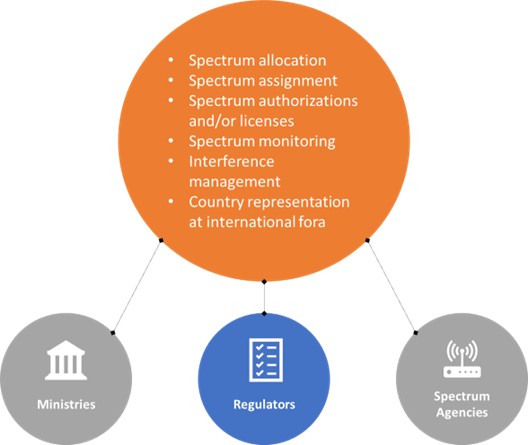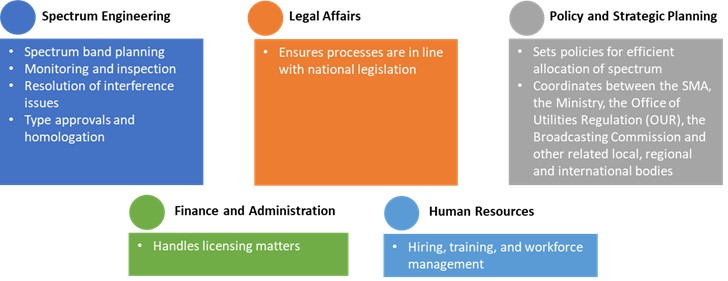The role of the regulator on national spectrum issues
25.04.2025Introduction to regulator’s role in national spectrum management
In the telecommunication and information and communication technologies (ICT) sectors, having a stable regulatory framework and governance is key for effective regulation. Spectrum management is one of the many functions regulators perform, which may be challenging as new digital technologies and services emerge.
To properly face these challenges, it is important for administrations to consider how spectrum issues are addressed in the national government structure. Considering the technical nature of the spectrum management functions, pressure often exists to design regulatory structures and internal procedures to optimize the use of resources available and increase efficiency. It is important to establish a management or administrative body providing leadership and supervision for the implementation of the spectrum planning. Long-term planning is almost always a primary task at management level and one that cannot be delegated, due to the consequences and significance of the decisions to be taken (ITU 2019a, p. 4). This is even more evident when supporting the deployment of new technologies.
Regardless of which governmental agency or body is tasked with spectrum management, the key responsibilities include (ITU 2021):

Spectrum management responsibilities are typically carried out through one or a combination of the following: government ministries, ICT regulatory authorities, and spectrum management agencies. As discussed below, countries may distribute spectrum policy and management functions among ministries, regulators, and designated spectrum agencies, but the common thread for a successful approach is effective communication and coordination among relevant agencies to ensure the most efficient management of the finite spectrum resource.
Almost three out of four countries have the regulatory authorities responsible for spectrum management, while about one in five countries have the sector ministry handling spectrum management issues (ITU 2022).
Among the agencies that are designated as ICT regulators, most have jurisdiction over other issues as well. Among these, many are responsible for public utilities such as water, gas, sewage, and electricity. Sometimes telecommunication issues are handled by the same agency as transportation issues, including railroads.
Spectrum management within a ministry structure
In countries where ministries are responsible for spectrum management, there is a range of ways for that responsibility to be delegated. The ministry may be fully responsible for all spectrum management, from spectrum allocation and policy development through to assignment, licensing, and enforcement. In other cases, the ministry may share this responsibility with another ministry or the ICT regulator.
For example, Peru’s Ministry of Transport and Communications (MTC) is responsible for developing and implementing policies and regulations on spectrum allocation, assignment, licensing, and use. However, the MTC shares responsibility for spectrum auctions with another ministerial agency. While the MTC approves auction processes, a different governmental agency, ProInversion, carries out the auction. ProInversion is an agency that promotes private investment under the Ministry of Economy and Finance, and is managed by a board comprised of representatives from several ministerial offices, including the MTC.
While ministries tend to focus on policy issues rather than technical regulations, many countries have ministries also involved in homologation, testing, and certification. Type approval is directly related to spectrum management, as it is key to ensure compliance with technical standards and an interference-free operation, especially for license-exempt applications. South Korea’s National Radio Research Agency (RRA) is part of the Ministry of Science and ICT (MSIT) and manages the conformity assessment system that validates and assigns type approvals in the country.
Spectrum management under ICT regulatory authorities
In countries where spectrum management functions are housed within the ICT regulator, the authority is generally tasked with issuing spectrum licenses, developing spectrum regulations, enforcing obligations, and conducting spectrum auctions, as needed. In some cases, such as in Australia and Brazil, the regulator is also responsible for developing and approving national frequency allocation plans. Other regulators are restricted to providing technical input to a ministry, which in turn makes final decisions regarding allocations and licenses.
Brazil’s National Telecommunications Agency (ANATEL) is an example of a regulator with broad spectrum management responsibilities. In addition to implementing national telecommunications policies, ANATEL allocates and assigns frequencies, implements measures to reduce or eliminate harmful interference, and is responsible for homologation, including product certification and type approval. While ANATEL is the lead agency for spectrum issues, it works closely with Brazil’s Ministry of Science, Technology, Innovation, and Communications (MCTIC) to develop policy goals for the telecommunication sector. For example, ANATEL conducted Brazil’s multi-band 5G auction based on policy goals and guidelines established by the MCTIC, which attracted strong demand for spectrum and widespread participation from operators. (GSMA 2023).
Sometimes a regulator operates as a unit within a ministry, as is the case in Chile and Colombia. Within Chile’s Ministry of Transport and Telecommunications (MTT), there is a dedicated Undersecretariat of Telecommunications (SUBTEL), which is the technical body responsible for the regulation and promotion of telecommunication services, including spectrum management. While SUBTEL carries out many of the administrative and technical functions often under the purview of a country’s ICT regulatory agency, it operates under the organizational structure of the ministry.
Australia has taken a different approach in its regulatory structure by consolidating all spectrum management responsibilities within the Australian Media and Communications Authority (ACMA), including development of the national frequency allocation table. The ACMA is responsible for implementing the country’s legislation on media and communications issues, as well as related regulation. The ACMA is a converged regulator, established in 2005 with the merger of the Australian Broadcasting Authority and Australian Communications Authority. Its broad mandate includes issues related to telecommunications, broadcasting, radio communications and the Internet. Spectrum management, formerly the task of Australia’s Spectrum Management Agency, is now handled by the Communications Infrastructure Division of the ACMA.
Spectrum-specific agencies
Some countries have created designated agencies to manage spectrum-related issues on behalf of the government. The scope of their authority varies, but centralized spectrum management agencies generally provide leadership on issues like spectrum monitoring, allocation, and reduction of harmful interference. These designated agencies often contribute technical expertise to government decisions around spectrum management.
One example is Jamaica’s Spectrum Management Authority (SMA), which was established in 2000 following the passage of the National Telecommunications Act. The SMA serves as an advisory body to the Ministry of Science, Energy, and Technology (MSET) and is responsible for spectrum management issues including band planning, interference resolution, and type approval certification. The duties of the SMA are separated by function into five divisions (Jamaica, SMA, no date).

Key findings
The role of the regulator on national spectrum issues
|
References
Chile. Ministerio de Transportes y Telecomunicaciones (MTT), Reseña institucional. Ministerio de Transportes y Telecomunicaciones. http://www.mtt.gob.cl/resenainstitucional.
GSMA. 2023. “Spectrum Licensing Best Practice – Brazil. London, United Kingdom: GSMA. https://www.gsma.com/connectivity-for-good/spectrum/wp-content/uploads/2023/02/Brazil-Spectrum-Licensing-Best-Practice.pdf.
International Telecommunication Union (ITU) Telecommunication Development Bureau, 2022. DataHub. Geneva, Switzerland: ITU. https://datahub.itu.int/data/?i=100057&s=12593&v=chart.
International Telecommunication Union (ITU), 2019. Report ITU-R SM.2015-1: Methods for determining national long-term strategies for spectrum utilization. Geneva, Switzerland: ITU. https://www.itu.int/pub/R-REP-SM.2015. (a)
International Telecommunication Union (ITU) Telecommunication Development Bureau, 2019. World Telecommunication/ICT Regulatory Survey. Geneva, Switzerland: ITU. https://www.itu.int/en/ITU-D/Regulatory-Market/Pages/RegulatorySurvey.aspx. (b)
International Telecommunication Union (ITU), 2021. Report ITU-R SM.2093-4: Guidance on the regulatory framework for national spectrum management. Geneva, Switzerland: ITU. https://www.itu.int/dms_pub/itu-r/opb/rep/R-REP-SM.2093-4-2021-PDF-E.pdf.
Jamaica. Spectrum Management Authority (SMA). Organizational Structure. https://www.sma.gov.jm/organizational-structure-2/.
Last updated on: 28.04.2025